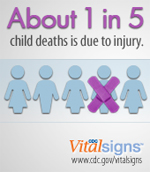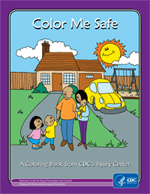
Road Traffic Injuries: The Reality
We all want to keep our children safe and secure and help them live to their full potential. Knowing how to prevent leading causes of child injury, like road traffic injuries, is a step toward this goal.
Every hour, nearly 150 children between ages 0 and 19 are treated in emergency departments for injuries sustained in motor vehicle crashes. More children ages 5 to 19 die from crash-related injuries than from any other type of injury.
Thankfully, parents can play a key role in protecting the children they love from road traffic injuries.
Prevention Tips
One of the best protective measures you can take is using seat belts, child safety seats, and booster seats that are appropriate for your child’s age and weight.
Know the Stages:
- Birth through Age 2 – Rear-facing child safety seat. For the best possible protection, infants and children should be kept in a rear-facing child safety seat, in the back seat buckled with the seat’s harness, until they reach the upper weight or height limits of their particular seat. The weight and height limits on rear-facing child safety seats can accommodate most children through age 2, check the seat’s owner’s manual for details.
- Between Ages 2-4/Until 40 lbs – Forward-facing child safety seat. When children outgrow their rear-facing seats (the weight and height limits on rear-facing car seats can accommodate most children through age 2) they should ride in forward-facing child safety seats, in the back seat buckled with the seat’s harness, until they reach the upper weight or height limit of their particular seat (usually around age 4 and 40 pounds; many newer seats have higher weight limits-check the seat’s owner’s manual for details).
- Between Ages 4-8 OR Until 4'9" Tall – Booster seat. Once children outgrow their forward-facing seats (by reaching the upper height and weight limits of their seat), they should ride in belt positioning booster seats. Remember to keep children in the back seat for the best possible protection.
- After Age 8 AND/OR 4'9" Tall – Seat belts. Children should use booster seats until adult seat belts fit them properly. Seat belts fit properly when the lap belt lays across the upper thighs (not the stomach) and the shoulder belt fits across the chest (not the neck). When adult seat belts fit children properly they can use the adult seat belts without booster seats. For the best possible protection keep children in the back seat and use lap-and-shoulder belts.
Back Seat is Safest. All children younger than 13 years should ride in the back seat. Airbags can kill young children riding in the front seat. Never place a rear-facing car seat in the front seat or in front of an air bag. Place children in the middle of the back seat when possible, because it is the safest spot in the vehicle.
Sign a Driving Agreement. If you’re a parent of a teen who is learning to drive, sign an agreement with them to limit risky driving situations, such as having multiple teen passengers and driving at night.
Helmets can Help. Children should wear an appropriate helmet any time they are on a motorcycle, bicycle, skateboard, scooter, or skates.
Get email updates
To receive email updates about this page, enter your email address:
Contact Us:
- Centers for Disease Control and Prevention
National Center for Injury Prevention and Control (NCIPC)
4770 Buford Hwy, NE
MS F-63
Atlanta, GA 30341-3717 - 800-CDC-INFO
(800-232-4636)
TTY: (888) 232-6348
New Hours of Operation:
8am-8pm ET/
Monday-Friday
Closed Holidays - cdcinfo@cdc.gov






